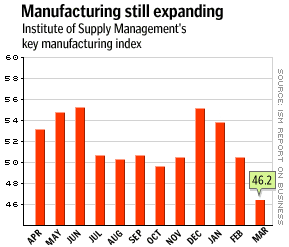NEW YORK (CNN/Money) -
U.S. manufacturing activity shrank for the first time in five months in March, the nation's purchasing managers said Tuesday, as the build-up to war in Iraq slowed demand for chemicals, electronics and industrial equipment.
The report puts the Federal Reserve in a tough spot -- it was dismal enough to inspire some observers to call for the central bank to cut interest rates, but Fed Chairman Alan Greenspan and other economists hope the weakness will disappear when the U.S.-led war with Iraq is over.

The Institute for Supply Management said its March index of manufacturing activity fell to 46.2 -- the lowest level since November 2001 -- from 50.5 in February.
Any reading below 50 indicates contraction in the sector, which has been mostly weak for two and a half years. Economists, on average, expected an index reading of 48.6, according to a Reuters poll.
"If the manufacturing sector remains mired in a recession mode for too long, it may be signaling the same for the rest of the economy," said Anthony Chan, chief economist at Banc One Investment Advisors. "Although it may be a bit too early to make that assessment, there should be universal agreement that the ISM outcome certainly does not bode well for the rest of the economy."
Two shoes have dropped
On Friday, the Labor Department is scheduled to release data on March unemployment and non-farm payrolls. Economists, on average, expect unemployment to creep up to 5.9 percent and for 29,000 jobs to be cut from payrolls, according to Reuters.
When the highly respected economists at the National Bureau of Economic Research pick the official dates of recessions, they look at four criteria, two of which are manufacturing and the labor market.
| Related Stories
|

|
|
|
|
Crummy data from both sectors in the same week, coming as they do during a time of dismal consumer confidence and some anxiety about the course of the war in Iraq, could inspire the Fed to cut its key short-term interest rate, already at 1.25 percent, a 40-year low.
The Fed's next policy meetings are scheduled for May 6 and June 24 and 25, but the Fed could very well cut rates before either of those meetings.
"The chances increase significantly for a [half-percentage-point] rate cut by the Fed by its June meeting," Vince Boberski, chief economist at RBC Dain Rauscher in Chicago, told Reuters. "I won't rule out an inter-meeting rate cut of 50 basis points."
Traders yawn
U.S. stock prices held steady after the release and rose in midday trade. Treasury bond prices fell.
Traders were either heartened by the possibility of another Fed rate cut, or perhaps they simply weren't too shocked by the report, since recent regional data from the Philadelphia Federal Reserve, the New York Fed and Chicago purchasing managers had already painted a stark picture of a significant decline in manufacturing activity as the nation prepared for war.
In the ISM report, new orders declined 6.1 percentage points to 46.2 percent in March, while production fell 9.1 percentage points to 46.3 percent. The employment index fell 0.7 percentage point to 42.1 percent, indicating the pace of layoffs in the manufacturing sector picked up in March.
Rising oil prices, driven mainly by the prelude to war and fears about how it would impact world supply, showed up in the prices paid index, which rose to 70.0 from 65.5 in February.
Manufacturers have been suffering for years. The industry's recession got a jump on the broader economic recession, in fact -- the ISM index fell to contraction levels in August 2000 and stayed under water until January 2002. About 2 million manufacturing jobs were cut during that time.
Manufacturing eked out some gains in 2002. But it suffered late in the year, along with other businesses, from fears about the possibility of war, leading to a Fed rate cut in November. Manufacturing recovered again in the winter, until the build-up to war brought it back down.
Hoping for a quick rebound
Still, few economists think one month's bad ISM report definitely equals a full-blown recession for the broader economy. Though last month's drop was dramatic, the 46.2 level points to slow growth. An ISM reading over 42.7, over a period of time, indicates that the overall economy, or gross domestic product, is generally expanding.
Ian Shepherdson, chief U.S. economist at High Frequency Economics, said Tuesday's ISM number implies year-to-year gross domestic product growth of about 1 percent.
"This level of the ISM is not consistent with recession," said Shepherdson, who does not expect a rate cut unless the stock market tumbles.
Click here for the full report
Most economists hope that, once the war is over, business activity will pick up. Other economists are concerned that there's too much overhanging debt and production capacity left over from the late 1990s investment bubble to allow businesses to spend and hire much more.
ISM Chairman Norbert J. Ore blamed the March manufacturing weakness on the prelude to war.
"Supply managers continue to be challenged by business conditions," Ore said. "The start of the war will begin to bring clarity to a difficult situation. In many ways, the threat of war was more intimidating than the actualization."
ISM, based in Tempe, Ariz., gathers the report's contents by surveying purchasing and supply executives in over 400 industrial companies.

|

